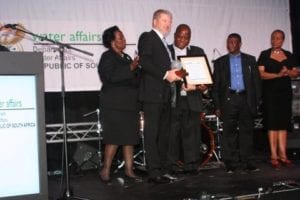The Water Research Commission (WRC) funded information system known as the Water Administration System (WAS), has been recognised by the Department of Water Affairs as one of the most innovative projects contributing to substantial water saving in major irrigation schemes in South Africa.
The developer of the WAS programme, Dr Nico Benadé proudly received the second placed Award under the Agricultural category of the Water Sector Awards in an event held on Friday, 18 October 2013 at Gallagher Convention Centre. This recognition comes a few weeks after Dr Benadé’s work was recognised by the WRC as being one of the most innovative management approaches. The winner in this category for 2013 was Lower Olifants River Water User Association (LORWUA) and their water conservation and water demand management achievements can also be largely attributed to effective implementation of WAS. WAS is a uniquely a South African integrated management tool for irrigation schemes that delivers water on demand through rivers, canal networks and pipelines. WAS is used for water distribution management and for the calculation of dam and canal operating procedures for a given downstream water demand. Twelve years of research went into the development of the WAS program with its main aim to minimize water losses on irrigation schemes. Field measurements indicated water savings between 10 to 20% on implementing the water release module of the WAS program alone. WAS currently consists of 8 modules with cross referencing of data. Among its many capabilities, the program is able to calculate water requests and releases and reports for river and canal networks, taking lag times and various water losses into account. Monthly invoices are generated automatically from water usage and scheduled area information captured in the database. WAS also promotes efficient water use at farm level by enabling water supply of the required volume at the requested time. The programme is currently used by all major irrigation schemes on a total of about 143 000 ha. This includes 9500 abstraction points, with a total water allocation of 1 163 million m3 . “Effective water loss can only be achieved through a comprehensive management system such as WAS,” notes Dr Benadé.“All of the irrigation schemes using WAS have reported water savings. At the Loskop, OranjeRiet and Lower Olifants Irrigation Schemes, for example, the water-supply losses in the canal system have been reduced over a number of years to 20% per year. In general, water losses of 20% and below are considered extremely well for irrigation schemes”, comments Dr Benadé.
In 2006, Dr Benadé received the WatSave Innovation Water Management Award from the International Commission on Irrigation and Drainage for his development and the implementation of WAS. In 2010 the same award was received by Vaalharts Water for outstanding achievement to save water. According to Vaalharts Water Head Control Officer Kobus Habron, water management was mainly a manual business prior to the installation of WAS. “All water orders, balances etc. were captured and calculated manually. This was a laborious, time-consuming process, leaving much room for human error “. Habron further explains, “At the Vaalharts Water Office eight computers have been installed to assist with the capturing of water orders and water control officers are now computer literate. With this program in place, paper work has been minimised and all reports are generated electronically”. Not only has WAS enabled the water user association to keep all their water usage information up to date and accurate, it has also freed up personnel. Rather than capturing data, their time is now spent out in the field inspecting and maintaining canal infrastructure and liaising with clients. Dr Gerhard Backeberg, Executive Manager for Water Utilisation in Agriculture at WRC comments, “Over the last 15 years implementation of WAS on irrigation schemes has practically proven that real water savings through water loss control are achievable. The higher the losses the bigger the opportunities are for savings”. The biggest challenge facing most water user associations today is the installation of water meters, training of water control officers and changing to a computerised integrated information system of WAS for water loss control. Visit the WAS website for more information www.nbsystems.co.za/ftp/was_module_documents.zip







